简介
设计模式可以分为五类
- 接口型 模式:适配器模式,外观模式,合成模式,桥接模式
- 职责型 模式:单例模式,观察者模式,调停者模式,代理模式,职责链模式,享元模式
- 构造型 模式:构建者模式,工厂方法模式,抽象工厂模式,原型模式,备忘录模式
- 操作型 模式:模板方法模式,状态模式,策略模式,命令模式,解析器模式
- 扩展型 模式:装饰器模式,迭代器模式,访问者模式。

接口类
适配器模式 通过一个接口来适配类的接口
接口的优点:限制了类之间的协作 , 即使实现类发生巨大变化, 接口的客户端也不受影响
不同场景下使用 的模式
- 适配类的接口,以匹配客户端期待的接口-->适配器模式
- 为一组类提供简单接口-->外观模式
- 为简单对象和复合对象提供统一接口-->合成模式
- 解除抽象与实现之间的耦合,使得二者独立演化-->桥接模式

1. 适配器模式
类适配器
使用继承方式,是静态的继承方式
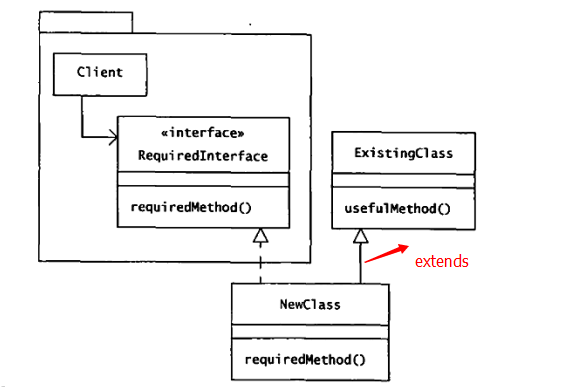
简述 :接口中的方法 分别在父类和子类中实现
写一个demo
接口中有两个方法
public interface Target {
void firstMethod();
void secondMethod();
}
adaptee只有一个方法
public class Adaptee {
public void firstMethod(){
System.out.println("this is first method.");
}
}
adapter 继承 adaptee 并实现 secondMethod
public class Adapter extends Adaptee implements Target {
@Override
public void secondMethod() {
System.out.println("this second method.");
}
}
对象适配器
采用委派的方式
将 adaptee组合到 adpter2中
写个demo
public class Adapter2 implements Target{
private Adaptee adaptee;
public Adapter2(Adaptee adaptee) {
this.adaptee = adaptee;
}
@Override
public void firstMethod() {
this.adaptee.firstMethod();
}
@Override
public void secondMethod() {
System.out.println("this second method.");
}
}
优点:代码复用,扩展 ,灵活 ,强大
缺点:是系统零乱 不易把握
2.外观模式
外观模式的意图是为 子系统 提供提供一个接口, 方便使用
外观类可能全是静态方法
简单描述一下 为复杂的子系统 提供一个 简单的调用门面
网上找了个易于理解的例子 http://www.aichengxu.com/java/681321.htm
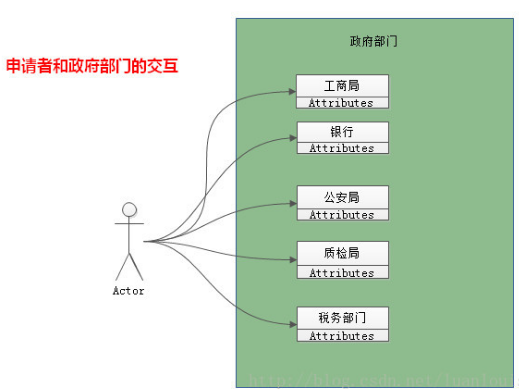
一个人申请开公司 他需要分别 去 工商局,银行,公安局,质监局,税务部门 办理相关手续 特别麻烦
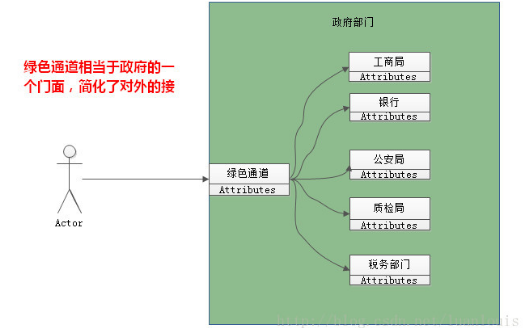
现在 有个绿色通道 ,actor只要 和它对接 既可以完成 上述操作 这个 绿色通道便可以看成是 一个 facade
这样看来 facade 模式 减少了客户端和 各个子系统之间交互,减少耦合。使接入变得简单
写一个简单的demo
工商系统
public class Indutry {
void regist(){
System.out.println("indutry registration.");
}
}
公安系统
public class PoliceStation {
void regist(){
System.out.println("police station registration.");
}
}
税务系统
public class RevenueDepartment {
void regist(){
System.out.println("revenue department registration.");
}
}
facade
public class Facade {
public void buildCompany() {
Indutry indutry = new Indutry();
PoliceStation policeStation = new PoliceStation();
RevenueDepartment revenueDepartment = new RevenueDepartment();
indutry.regist();
policeStation.regist();
revenueDepartment.regist();
}
}
3.合成模式
composite :组合对象 ,单对象 。组对象和单对象有共同的行为
组合对象 可以包括其他组合对象,也可以包括单对象。
合成模式 作用:保证客户端调用 单对象与组合对象的一致性
安全合成模式
管理聚集的方法 只出现在树枝构建中
写一个demo
相同接口
public interface Component {
void printStruct(String preStr);
}
组合
public class Composite implements Component {
private List<Component> childComponens = new ArrayList<Component>();
private String name;
public void add(Component child) {
childComponens.add(child);
}
public void remove(int index) {
childComponens.remove(index);
}
public Composite(String name) {
this.name = name;
}
public List<Component> getChildComponens() {
return childComponens;
}
public void setChildComponens(List<Component> childComponens) {
this.childComponens = childComponens;
}
public String getName() {
return name;
}
public void setName(String name) {
this.name = name;
}
@Override
public void printStruct(String preStr) {
System.out.println(preStr + "-->" + name);
if (childComponens != null) {
preStr += " ";
for (Component child : childComponens) {
//递归调用
child.printStruct(preStr);
}
}
}
}
叶子节点
public class Leaf implements Component {
private String name;
public Leaf(String name) {
this.name = name;
}
public String getName() {
return name;
}
public void setName(String name) {
this.name = name;
}
@Override
public void printStruct(String preStr) {
System.out.println(preStr+"-->"+name);
}
}
测试
public void test(){
Composite root=new Composite("knowledge");
//java 节点
Composite java=new Composite("java");
Composite map=new Composite("Map");
map.add(new Leaf("HashMap"));
map.add(new Leaf("TreeMap"));
java.add(new Leaf("JVM"));
java.add(new Leaf("List"));
java.add(map);
//spring节点
Composite spring=new Composite("spring");
spring.add(new Leaf("AOP"));
spring.add(new Leaf("IOC"));
// root add
root.add(java);
root.add(spring);
root.printStruct("");
}
运行结果
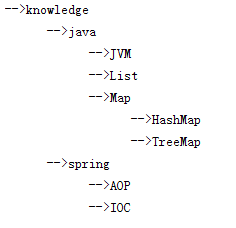
4. 桥接模式
桥接模式 (bridge)关注抽象
桥接模式的意图 是 将 抽象与抽象方法的实现 相互分离出来, 实现 解耦合,以便二者可以相互独立
简单的说 就是 将对象 与方法分离
书上看到一个例子:现在有 2种设备 分别有 启动 关闭 2个抽象方法。
写个简单的 demo
抽象设备
public abstract class AbstractMachine {
private MechineMethod mechineMethod;
public void setMechineMethod(MechineMethod mechineMethod) {
this.mechineMethod = mechineMethod;
}
public MechineMethod getMechineMethod() {
return mechineMethod;
}
abstract void checkMethod();
}
设备A
public class MachineA extends AbstractMachine {
@Override
void checkMethod() {
System.out.println("check machine A ......");
}
}
设备B
public class MachineB extends AbstractMachine {
@Override
void checkMethod() {
System.out.println("check machine B ......");
}
}
要检测的功能 的抽象类 (这里对方法的处理 将常规的 竖 转 横,方法平铺 )
public abstract class MechineMethod {
abstract void methodRun();
}
start功能
public class StartMethod extends MechineMethod {
@Override
void methodRun() {
System.out.println("start method running.");
}
}
close功能
public class CloseMethod extends MechineMethod {
@Override
void methodRun() {
System.out.println("close method running.");
}
}
测试 检测 A设备的Start功能
//检测A设备的 start功能
public void test() {
//检测A设备的 start功能
AbstractMachine machine = new MachineA();
MechineMethod mechineMethod = new StartMethod();
machine.setMechineMethod(mechineMethod);
machine.checkMethod();
machine.getMechineMethod().methodRun();
}
输出结果

职责类
我们常见的职责模式 如
根据可见性控制职责 :java代码中的 public,private,protected

职责设计模式
- 将职责集中到某个类的单个实例中-->单例模式
- 将对象从依赖它的对象中解耦-->观察者模式
- 将职责集中在某个类,该类可以监督其他对象的交互-->调停者模式
- 让一个对象扮演其他对象的行为--代理模式
- 允许将职责链的请求传递给其他对象,直到这个请求被某个对象处理-->职责链模式
- 将共享的 细粒度的职责 进行集中管理-->享元模式

1. 单例模式
单例模式 : 是确保一个类的 有且仅有一个实例,并为它提供一个全局访问点
单例模式中 往往使用 static关键字
static 修饰的变量为 静态变量,静态变量只在类第一次调用的时候加载 ,在内存中只有一个副本。

1.饿汉模式
public class EagerSingleton {
private static EagerSingleton eagerSingleton=new EagerSingleton();
private EagerSingleton() {
}
public EagerSingleton getSingleton(){
return eagerSingleton;
}
}
2.懒加载模式
public class LazzySingleton {
private static LazzySingleton lazzySingleton;
private LazzySingleton() {
}
//同步方法
public static synchronized LazzySingleton getSingleton() {
if (lazzySingleton == null) {
lazzySingleton = new LazzySingleton();
}
return lazzySingleton;
}
}
3. 支持多线程
public class Singleton {
private static Singleton singleton;
private Singleton() {
}
public static Singleton getSingleton() {
//先条件 后程序
if (singleton == null) {
//锁 住整个对象
synchronized (Singleton.class) {
singleton = new Singleton();
}
}
return singleton;
}
}
2. 观察者模式
Observer [əbˈzɜ:rvə(r)]
观察者模式:在多个对象之间定义一对多依赖关系,当一个对象的状态发生改变时,通知你依赖于它的对象,并根据新状态做出相应反应。
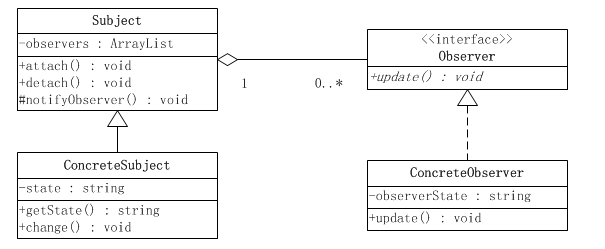
写一个demo
如 写一个 微博更新自动推送给客户
抽象 WeiBo 父类
public abstract class WeiBo {
//保存 Observer
private List<Observer> list = new ArrayList<Observer>();
public void addObserver(Observer observer) {
list.add(observer);
}
public void delObserver(Observer observer) {
list.remove(observer);
}
//通知所有观察者
public void notifyObservers(String operation) {
for (Observer observer : list) {
observer.update(operation);
}
}
}
具体的Video类
public class Video extends WeiBo {
private String operation;
public String getOperation() {
return operation;
}
public void change(String operation) {
this.operation = operation;
notifyObservers(operation);
}
}
观察者接口
public interface Observer {
public void update(String operation);
}
监听文件大小的观察者
public class ObserverSize implements Observer {
private String operation;
@Override
public void update(String operation) {
this.operation = operation;
System.out.println("Observer Size : " + operation);
}
}
写一个测试的demo
public void test() {
Video video = new Video();
Observer observer = new ObserverSize();
video.addObserver(observer);
video.change("compress video");//压缩视频
}
运行结果

推模式
主题发生改变时自动推送给观察者 ,不管观察者是否需要,主题推送的通常是主题对象的全部数据 或部分数据
拉模式
主题发生改变时 只传递少了信息给观察者 ,观察者根据需再向主题拉取数据。
java 提供的观察者支持类
Observable
Observable [əbˈzərvəbəl] 可观察
被观察的类只要继承该类即可。

public class Observable {
private boolean changed = false;
private Vector<Observer> obs;
/** Construct an Observable with zero Observers. */
public Observable() {
obs = new Vector<>();
}
/**
* Adds an observer to the set of observers for this object, provided
* that it is not the same as some observer already in the set.
* The order in which notifications will be delivered to multiple
* observers is not specified. See the class comment.
*
* @param o an observer to be added.
* @throws NullPointerException if the parameter o is null.
*/
public synchronized void addObserver(Observer o) {
if (o == null)
throw new NullPointerException();
if (!obs.contains(o)) {
obs.addElement(o);
}
}
/**
* Deletes an observer from the set of observers of this object.
* Passing <CODE>null</CODE> to this method will have no effect.
* @param o the observer to be deleted.
*/
public synchronized void deleteObserver(Observer o) {
obs.removeElement(o);
}
/**
* If this object has changed, as indicated by the
* <code>hasChanged</code> method, then notify all of its observers
* and then call the <code>clearChanged</code> method to
* indicate that this object has no longer changed.
* <p>
* Each observer has its <code>update</code> method called with two
* arguments: this observable object and <code>null</code>. In other
* words, this method is equivalent to:
* <blockquote><tt>
* notifyObservers(null)</tt></blockquote>
*
* @see java.util.Observable#clearChanged()
* @see java.util.Observable#hasChanged()
* @see java.util.Observer#update(java.util.Observable, java.lang.Object)
*/
public void notifyObservers() {
notifyObservers(null);
}
/**
* If this object has changed, as indicated by the
* <code>hasChanged</code> method, then notify all of its observers
* and then call the <code>clearChanged</code> method to indicate
* that this object has no longer changed.
* <p>
* Each observer has its <code>update</code> method called with two
* arguments: this observable object and the <code>arg</code> argument.
*
* @param arg any object.
* @see java.util.Observable#clearChanged()
* @see java.util.Observable#hasChanged()
* @see java.util.Observer#update(java.util.Observable, java.lang.Object)
*/
public void notifyObservers(Object arg) {
/*
* a temporary array buffer, used as a snapshot of the state of
* current Observers.
*/
Object[] arrLocal;
synchronized (this) {
/* We don't want the Observer doing callbacks into
* arbitrary code while holding its own Monitor.
* The code where we extract each Observable from
* the Vector and store the state of the Observer
* needs synchronization, but notifying observers
* does not (should not). The worst result of any
* potential race-condition here is that:
* 1) a newly-added Observer will miss a
* notification in progress
* 2) a recently unregistered Observer will be
* wrongly notified when it doesn't care
*/
if (!changed)
return;
arrLocal = obs.toArray();
clearChanged();
}
for (int i = arrLocal.length-1; i>=0; i--)
((Observer)arrLocal[i]).update(this, arg);
}
/**
* Clears the observer list so that this object no longer has any observers.
*/
public synchronized void deleteObservers() {
obs.removeAllElements();
}
/**
* Marks this <tt>Observable</tt> object as having been changed; the
* <tt>hasChanged</tt> method will now return <tt>true</tt>.
*/
protected synchronized void setChanged() {
changed = true;
}
/**
* Indicates that this object has no longer changed, or that it has
* already notified all of its observers of its most recent change,
* so that the <tt>hasChanged</tt> method will now return <tt>false</tt>.
* This method is called automatically by the
* <code>notifyObservers</code> methods.
*
* @see java.util.Observable#notifyObservers()
* @see java.util.Observable#notifyObservers(java.lang.Object)
*/
protected synchronized void clearChanged() {
changed = false;
}
/**
* Tests if this object has changed.
*
* @return <code>true</code> if and only if the <code>setChanged</code>
* method has been called more recently than the
* <code>clearChanged</code> method on this object;
* <code>false</code> otherwise.
* @see java.util.Observable#clearChanged()
* @see java.util.Observable#setChanged()
*/
public synchronized boolean hasChanged() {
return changed;
}
/**
* Returns the number of observers of this <tt>Observable</tt> object.
*
* @return the number of observers of this object.
*/
public synchronized int countObservers() {
return obs.size();
}
}
Observer
观察者只要实现该类即可。
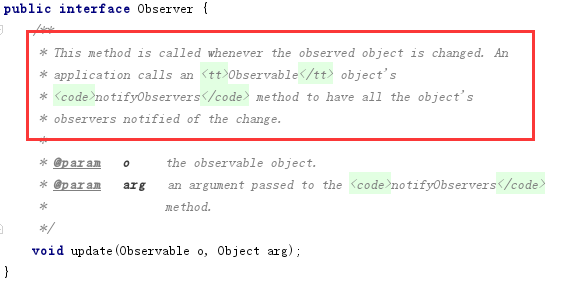
3. 调停者模式 Mediator
mediator [ˈmēdēˌātər] :中间人
调停者模式:定义一个对象,封装一组对象的交互,从而降低对象间的耦合度,避免了对象之间的显示引用,并且可以独立的改变对象间的行为。
复杂的调用关系
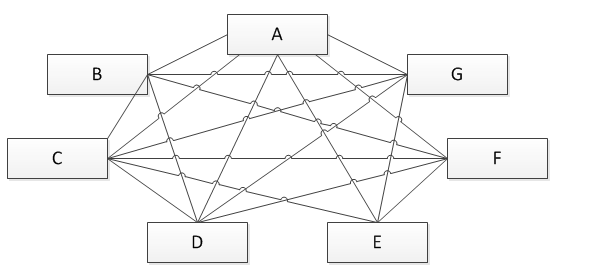
引入 mediator
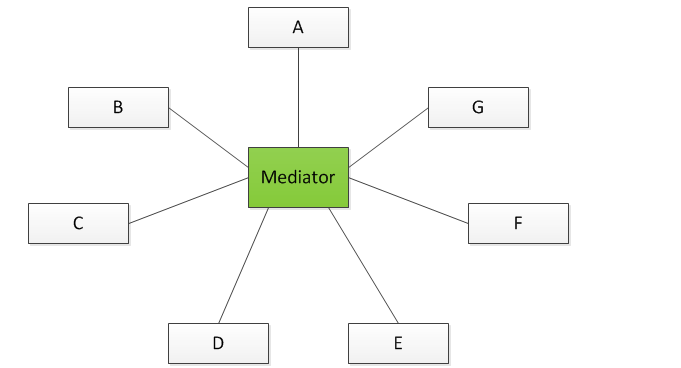

写个demo
Mediator 接口
public interface Mediator {
void changed(Component component);
}
将A,B,C...等组件 抽象出一个父类
/**
* A,B,C,D...抽象出一个父类 叫 Colleague
* 因为 调停者 要和 A,B,C,D..组件关联 所以将它注入到各组件中(抽象到父类里)
*/
public abstract class Component {
private Mediator mediator;
public Component(Mediator mediator) {
this.mediator = mediator;
}
public Mediator getMediator() {
return mediator;
}
}
组件A
public class ComponetA extends Component {
public ComponetA(Mediator mediator) {
super(mediator);
}
public void start(){
getMediator().changed(this);//通过Mediator 调停者 通知 其他组件
}
}
组件B
public class ComponetB extends Component {
public ComponetB(Mediator mediator) {
super(mediator);
}
public void start(){
getMediator().changed(this);//通过Mediator 调停者 通知 其他组件
}
}
实现 Mediator 类
public class MediatorConcrete implements Mediator {
//调停者 要交互 其他组件 所以 其他组件 要注入调停者里面
private ComponetA colleagueA;
private ComponetB colleagueB;
public void setColleague(ComponetA colleagueA, ComponetB colleagueB) {
this.colleagueA = colleagueA;
this.colleagueB = colleagueB;
}
@Override
public void changed(Component colleague) {
//通知给其他组件
if (colleague instanceof ComponetA) {
System.out.println("hi B,ComponetA start");
} else if (colleague instanceof ComponetB) {
System.out.println("hi A,ComponetB start");
}
}
}
测试
public void test(){
//实例化一个调停者
MediatorConcrete mediator = new MediatorConcrete();
//创建两个组件,放入调停者(要通过调停者传递消息)
ComponetA a = new ComponetA(mediator);
ComponetB b = new ComponetB(mediator);
//交互的组件放入 (因为一个组件change,要通知其他组件)
mediator.setColleague(a,b);
a.start();//a组件启动
}
运行结果

4. 代理模式 Proxy
代理对象通常拥有一个几乎和实际对象相同的接口。它常常会控制访问,并将请求合理的转发给底层的真实对象。
Java 代理
- 静态代理
- 动态代理
静态代理
client-->subject-->proxy-->realSubject
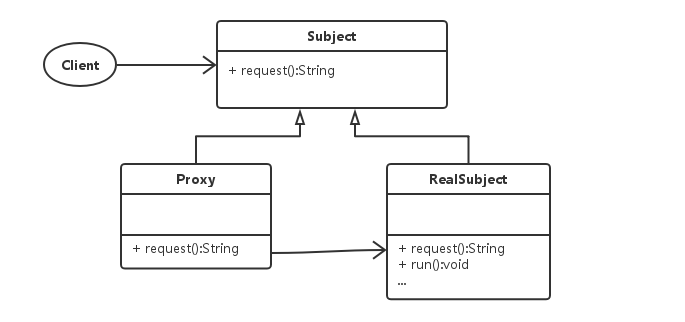
realSubject : 委托类
proxy : 代理类
subject : 委托类和代理类的接口
静态代理中 一个委托类 realSubject 对应一个代理类 proxy 代理类在编译期间就已经确定
动态代理
Java 动态代理
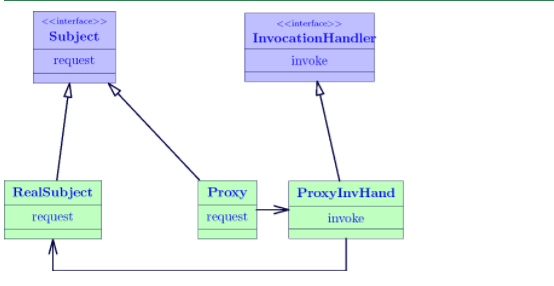
动态代理的代理类 不是在Java代码中实现 是在运行期生成
1.定义接口 SubjectService
public interface SubjectService {
void add();
}
2.定义委托类 RealSubjectServiceImpl
public class RealSubjectServiceImpl implements SubjectService {
@Override
public void add() {
System.out.println("init real sub service.");
}
}
3.定义 myInvocationHandler 实现java.lang.reflect.InvocationHandler接口
m.invoke(obj,args) : 对目标对象的调用转发给 包装对象
public class MyInvocationHandler implements InvocationHandler {
private Object target;//目标对象
public MyInvocationHandler(Object target) {
this.target = target;
}
@Override
public Object invoke(Object proxy, Method method, Object[] args) throws Throwable {
System.out.println(".....before......");
Object result=method.invoke(target,args);
System.out.println(".....after......");
return result;
}
public Object getProxy(){
return Proxy.newProxyInstance(Thread.currentThread().getContextClassLoader(),target.getClass().getInterfaces(),this);
}
}
4.测试
@Test
public void proxyTest(){
MyInvocationHandler handler=new MyInvocationHandler(new RealSubjectServiceImpl());
//proxy
SubjectService proxy= (SubjectService) handler.getProxy();
proxy.add();
}
运行结果

cglib动态代理
cglib底层使用 ASM 重写 非 final 方法实现
1.创建 自己的方法拦截器 MyMethodInterceptor 实现 MethodInterceptor
2.通过 net.sf.cglib.proxy.Enhancer 创建代理对象
public class MyMethodInterceptor implements MethodInterceptor {
private Object target;
public MyMethodInterceptor(Object target) {
this.target = target;
}
@Override
public Object intercept(Object obj, Method method, Object[] args, MethodProxy proxy) throws Throwable {
System.out.println(".....before......");
Object result=proxy.invokeSuper(obj,args);
System.out.println(".....before......");
return result;
}
public Object getProxy(){
Enhancer enhancer=new Enhancer();
enhancer.setCallback(this);
enhancer.setSuperclass(target.getClass());
return enhancer.create();
}
}
测试.
@Test
public void cglibTest(){
MyMethodInterceptor interceptor=new MyMethodInterceptor(new RealSubjectServiceImpl());
SubjectService proxy= (SubjectService) interceptor.getProxy();
proxy.add();
}
5. 职责链模式 chain of responsibility
职责链模式 通过给予多个对象处理请求的机会,以解除请求的发送者与接收者之间的耦合。
简单的说 :请假3天假-->leader审批-->经理审批-->人事审批
或者
我只请半天假-->leader审批-->人事审批
职责链的节点 可以自由组合
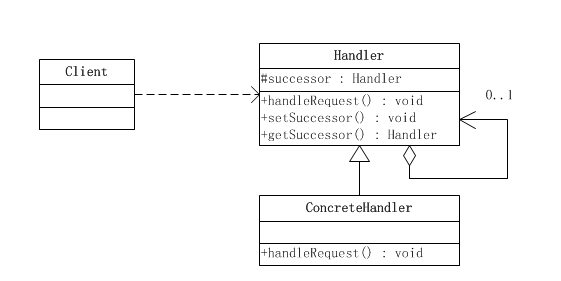
抽象一个Hander父类
public abstract class Handler {
private Handler next;//后续责任对象
public Handler getNext() {
return next;
}
public void setNext(Handler next) {
this.next = next;
}
public abstract void handleRequest();//处理请求
}
A节点
public class HanderA extends Handler{
@Override
public void handleRequest() {
System.out.println("A done..");
if(getNext()!=null){
getNext().handleRequest();
}else {
System.out.println("finish..");
}
}
}
B节点
public class HanderB extends Handler{
@Override
public void handleRequest() {
System.out.println("B done..");
if(getNext()!=null){
getNext().handleRequest();
}else {
System.out.println("finish..");
}
}
}
c节点
public class HanderC extends Handler{
@Override
public void handleRequest() {
System.out.println("C done..");
if(getNext()!=null){
getNext().handleRequest();
}else {
System.out.println("finish..");
}
}
}
测试
public void test(){
Handler a=new HanderA();
Handler b=new HanderB();
Handler c=new HanderC();
a.setNext(b);
b.setNext(c);
a.handleRequest();
}
执行结果
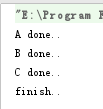
6. 享元模式 flyweight
享元模式 在客户对象之间提供共享对象,并且为共享对象创建职责
共享对象发生改变 时 不需要通知其他客户端
享元模式的目的是:通过共享来支持大量细粒度对象
1.享元模式 可以 使你共享的访问 大量出现的细粒度对象
2.享元对象必须是不可变的
3.不变的部分提取出来
4.为了确保享元对象共享 ,需要强制客户端通过享元工厂来访问
5.享元工厂 做好权限限制
不变性
可以设置成枚举
java 中的String就是 享元模式
1.单纯享元模式
所有的享元对象都可以共享
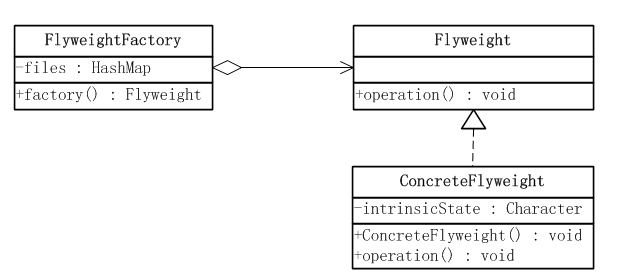
抽象一个接口
public interface Flyweight {
void operation(String state);
}
实现一个享元对象
public class FlyweightA implements Flyweight {
//共享对象状态
private Character inState;
public FlyweightA(Character inState) {
this.inState = inState;
}
@Override
public void operation(String state) {
//state 改变方法的行为 单 不改变 共享对象的状态
System.out.println("param :"+state);
System.out.println("state:"+inState);
}
}
享元工厂
public class FlyweightFactory {
private Map<Character,Flyweight> files=new HashMap<Character, Flyweight>();
public Flyweight factory(Character state){
Flyweight flyweight=files.get(state);
if(flyweight==null){
flyweight=new FlyweightA(state);
files.put(state,flyweight);
}
return flyweight;
}
}
测试
public class FlyweightTest {
@Test
public void test() {
FlyweightFactory factory = new FlyweightFactory();
Flyweight flyweight = factory.factory(new Character('0'));
flyweight.operation("test 1");
flyweight = factory.factory(new Character('1'));
flyweight.operation("test B");
}
}
运行结果
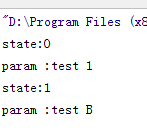
2.复合享元模式
复合享元模式 意思是 单个享元对象 组成一个集合,而这个集合本身不是共享的
就是 将上述的例子 instate改成一个集合
demo
接口
public interface Flyweight {
void operation(String state);
}
单个享元
public class FlyweightA implements Flyweight {
//共享对象状态
private Character inState;
public FlyweightA(Character inState) {
this.inState = inState;
}
@Override
public void operation(String state) {
//state 改变方法的行为 单 不改变 共享对象的状态
System.out.println("param :"+state);
System.out.println("state:"+inState);
}
}
复合享元
public class FlyweightB implements Flyweight {
//复合享元模式
private Map<Character,Flyweight> files=new HashMap<Character, Flyweight>();
@Override
public void operation(String state) {
for(Flyweight flyweight:files.values()){
flyweight.operation(state);
}
}
public void add(Character key,Flyweight value){
files.put(key,value);
}
}
享元工厂
public class FlyweightFactory {
private Map<Character,Flyweight> files=new HashMap<Character, Flyweight>();
//集合工厂
public Flyweight factory(List<Character> states){
FlyweightB b=new FlyweightB();
for(Character c:states){
//调用 单个构建
b.add(c,factory(c));
}
return b;
}
//单参构建
public Flyweight factory(Character state){
//先从缓存中查找对象
Flyweight fly = files.get(state);
if(fly == null){
//如果对象不存在则创建一个新的Flyweight对象
fly = new FlyweightA(state);
//把这个新的Flyweight对象添加到缓存中
files.put(state, fly);
}
return fly;
}
}
测试
public void test(){
//工厂构建数据
FlyweightFactory flyweightFactory=new FlyweightFactory();
List<Character> param= Arrays.asList('0','1','2');
Flyweight flyweight=flyweightFactory.factory(param);
//操作
flyweight.operation("test..");
}
运行结果

构造类
- 在请求 创建对象之前 ,逐渐收集创建对象的信息-->构建者模式
- 推迟实例化的类对象-->工厂方法模式
- 创建一组 有共同特征的对象-->抽象工厂
- 根据现有对象 创建一个对象-->原型模式
- 通过对象内部静态版本 重构对象-->备忘录模式

1.构建者模式 Builder
构建者模式 :将类的实例化逻辑 转移到类的外部。
构建模式 :将构建与对象分离 。将复杂对象的构建逻辑从对象本身抽离,这样能够简化复杂对象
网上找了个例子 http://www.blogjava.net/fancydeepin/archive/2012/08/05/384783.html
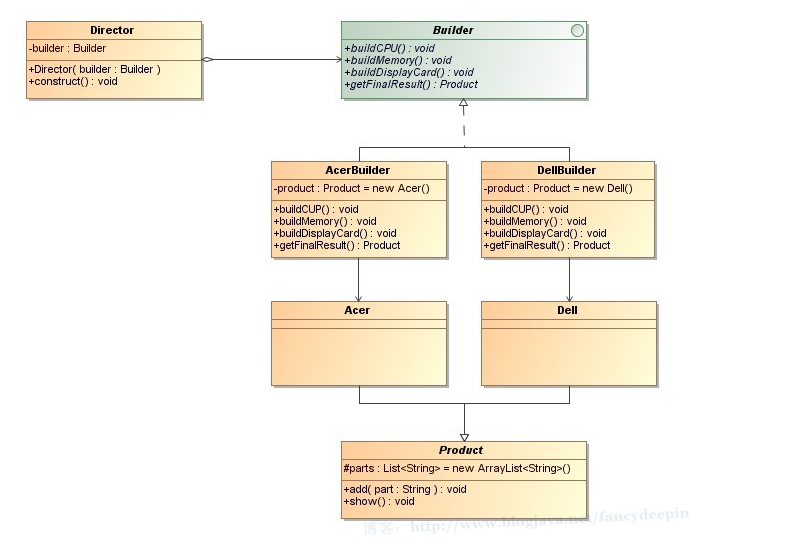
我们现在需要生产一个产品 :电脑
简单的描述 就是 产品(电脑) 是一个类,构建(builder) 是一个类
然后 将 产品 放入 builder中构建
看代码:
产品
public abstract class Product {
protected List<String> parts = new ArrayList<String>();//存储产品的各个部件
//add
public void add(String part) {
parts.add(part);
}
//show product
public void show() {
for (String s : parts) {
System.out.println(s);
}
}
}
宏碁电脑
public class Acer extends Product {
}
戴尔电脑
public class Dell extends Product {
}
构建者接口
public interface Builder {
//构建产品 的几个步骤
void buildCPU();
void buildMemory();
void buildGraphicsCard();
Product getResult();
}
实现 宏碁电脑构建
public class AcerBuilder implements Builder {
//产品和构建分离
//创建Acer产品 进行 构建
private Product product=new Acer();
@Override
public void buildCPU() {
product.add("cpu:i5");
}
@Override
public void buildMemory() {
product.add("memory:8G");
}
@Override
public void buildGraphicsCard() {
product.add("graphics card:HD");
}
@Override
public Product getResult() {
return product;
}
}
实现戴尔电脑构建
public class DellBuilder implements Builder {
//产品和构建分离
//创建Dell产品 进行 构建
private Product product = new Dell();
@Override
public void buildCPU() {
product.add("cpu:i7");
}
@Override
public void buildMemory() {
product.add("memory:16G");
}
@Override
public void buildGraphicsCard() {
product.add("graphics card:HD");
}
@Override
public Product getResult() {
return product;
}
}
指导构建过程
public class Director {
private Builder builder;
public Director(Builder builder) {
this.builder = builder;
}
public void Construct() {
//控制 构建逻辑顺序
builder.buildCPU();
builder.buildMemory();
builder.buildGraphicsCard();
}
}
测试
public void test() {
System.out.println("acer");
AcerBuilder acerBuilder = new AcerBuilder();
Director director = new Director(acerBuilder);
director.Construct();
//Product show
acerBuilder.getResult().show();
System.out.println("..............");
System.out.println("dell");
DellBuilder dellBuilder = new DellBuilder();
director = new Director(dellBuilder);
director.Construct();
//Product show
dellBuilder.getResult().show();
}
运行结果
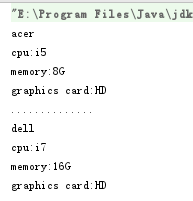
2.工厂方法 factory method
工厂方法:让服务提供者 确定实例化哪个类,而不是客户端代码
网上找了个 demo http://blog.csdn.net/jason0539/article/details/23020989
简单工厂模式
简单工厂模式 又称 静态工厂模式
客户需要一辆宝马车,客户不必自己亲自造一辆宝马车 。我们可以建立一个工厂 ,工厂负责宝马车的创建,降低 客户和宝马的耦合
首先我们抽象一个BMW类
public abstract class BMW {
}
有两种型号的 BMW
public class BMW320 extends BMW {
public BMW320() {
System.out.println("build bmw 320.");
}
}
BMW523
public class BMW523 extends BMW {
public BMW523() {
System.out.println("build bmw 523.");
}
}
工厂 根据传参 创建 相应产品
public class SimpleFactory {
public BMW createBMW(int param) {
switch (param) {
case 320:
return new BMW320();
case 523:
return new BMW523();
default:
break;
}
return null;
}
}
测试
public void test(){
SimpleFactory factory=new SimpleFactory();
factory.createBMW(320);
factory.createBMW(523);
}
运行结果

工厂方法模式
简单工厂中 当客户需要 一个新产品时, simpleFactory需修改 case代码 去创建新的代码 ,这样 simpleFactory的代码会频繁改动 很是被动。这也违背了 设计模式的开闭原则。
这时 我们可以把 case部分的 静态代码抽出来,分成不同的子工厂。
Factory接口
public interface Factory {
BMW createBMW();
}
320子工厂
public class FactoryBMW320 implements Factory {
@Override
public BMW createBMW() {
return new BMW320();
}
}
523子工厂
public class FactoryBMW523 implements Factory {
@Override
public BMW createBMW() {
return new BMW523();
}
}
测试
public void test(){
FactoryBMW320 factoryBMW320=new FactoryBMW320();
factoryBMW320.createBMW();
FactoryBMW523 factoryBMW523=new FactoryBMW523();
factoryBMW523.createBMW();
}
运行结果

3.抽象工厂 abstract factory
抽象工厂 创建不同的产品簇
还按上面的例子说 客户不是简单要一个BMW, 每个客户有 不同的 发动机和变速箱需求。
先创建两个类 发动机,变速箱
发动机
public abstract class Engine {
}
4缸发动机
public class Engine4 extends Engine {
public Engine4() {
//生产 四缸发动机
System.out.println("create N46.");
}
}
12缸发动机
public class Engine12 extends Engine {
public Engine12() {
//生产 12缸发动机
System.out.println("create M73.");
}
}
变速箱
public abstract class Gearbox {
}
手动变速
public class ManualGearbox extends Gearbox {
public ManualGearbox() {
System.out.println("create manual transmission.");
}
}
自动变速
public class AutomaticGearbox extends Gearbox {
public AutomaticGearbox() {
System.out.println("create automatic transmission.");
}
}
抽象工厂
public interface AbstractFactory {
Engine createEngine();
Gearbox createGearbox();
}
产品12工厂:12缸发动机,自动变速箱
public class FactoryBMW12 implements AbstractFactory {
@Override
public Engine createEngine() {
return new Engine12();
}
@Override
public Gearbox createGearbox() {
return new AutomaticGearbox();
}
}
产品 46 工厂 :4缸发动机,手动变速
public class FactoryBMW46 implements AbstractFactory {
@Override
public Engine createEngine() {
return new Engine4();
}
@Override
public Gearbox createGearbox() {
return new ManualGearbox();
}
}
测试
public void test(){
System.out.println("bmw 12 :");
FactoryBMW12 factoryBMW12=new FactoryBMW12();
factoryBMW12.createEngine();
factoryBMW12.createGearbox();
System.out.println("............");
System.out.println("bmw 46 :");
FactoryBMW46 factoryBMW46=new FactoryBMW46();
factoryBMW46.createEngine();
factoryBMW46.createGearbox();
}
执行结果
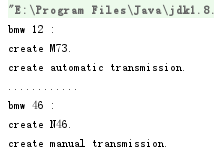
4.原型模式 prototype
原型模式使用户复制对象样本来创建对象。而不是通过实例化的方式。
原型模式的核心是克隆方法,java 提供了 Cloneable接口 。
写个demo
public class Student implements Cloneable {
private String code;
List<String> courses;
public List<String> getCourses() {
return courses;
}
public void setCourses(List<String> courses) {
courses = courses;
}
public void addCourse(String course) {
if(courses==null) courses=new ArrayList<String>();
courses.add(course);
}
public String getCode() {
return code;
}
public void setCode(String code) {
this.code = code;
}
@Override
protected Student clone() {
try {
return (Student) super.clone();
} catch (CloneNotSupportedException e) {
e.printStackTrace();
}
return null;
}
@Override
public String toString() {
return this.code
+",Courses : "+ Arrays.toString(courses.toArray());
}
}
原型模式 内存二进制流copy,要比直接new性能好 。
new 的时候 也许受权限限制 ,使用原型模式可以访问一些私有对象
浅拷贝
public void test(){
Student student=new Student();
student.setCode("001");
student.addCourse("math");
Student studentB=student.clone();
studentB.setCode("001B");
studentB.addCourse("java");
studentB.addCourse("C#");
System.out.println(student.toString());
System.out.println(studentB.toString());
}
输出

可以发现 studenB的 Courses变化 会影响到 原始Student
因为 Object提供的clone只Copy对象 对象中数组和引用对象都未copy,指向的还是元数据的 地址。
深拷贝
可以通过流式copy进行深copy
public class Teacher implements Serializable{
private String code;
List<String> courses;
public List<String> getCourses() {
return courses;
}
public void setCourses(List<String> courses) {
courses = courses;
}
public void addCourse(String course) {
if(courses==null) courses=new ArrayList<String>();
courses.add(course);
}
public String getCode() {
return code;
}
public void setCode(String code) {
this.code = code;
}
@Override
public String toString() {
return this.code
+",Courses : "+ Arrays.toString(courses.toArray());
}
}
流 copy
public void testDeep(){
try {
Teacher teacher=new Teacher();
teacher.setCode("001");
teacher.addCourse("tech math");
//对象 写入缓存 bytes
//申明缓存空间
ByteOutputStream bytes=new ByteOutputStream();
//申明 对象写入
ObjectOutputStream out=new ObjectOutputStream(bytes);
//对象写入
out.writeObject(teacher);
//bytes中读取对象
ObjectInputStream inputStream=new ObjectInputStream(new ByteArrayInputStream(bytes.getBytes())) ;
Teacher teacherB= (Teacher) inputStream.readObject();
teacherB.setCode("001B");
teacherB.addCourse("tech java");
System.out.println(teacher.toString());
System.out.println(teacherB.toString());
} catch (Exception e) {
e.printStackTrace();
}
}
运行结果

5.备忘录模式 Memento
备忘录模式的目的是 为对象状态 提供存储和恢复功能。
备忘录模式的结构
Originator [əˈrijəˌnātər]
Caretaker [Care taker] 管理人

- 发起人:记录当前时刻内部状态,负责定义哪些属于备份范围的状态,负责创建和恢复备忘数据。
- 备忘录:负责存储 发起人对象的内部状态,需要的时候提供 发起人需要的内部状态
- 管理角色:对备忘录进行管理,保存和提供备忘数据。
发起人代码
public class Originator {
private String state="";
public String getState() {
return state;
}
public void setState(String state) {
this.state = state;
}
//创建备忘状态
public Memento createMemento(){
return new Memento(this.state);
}
//恢复备忘状态
public void restoreMemento(Memento memento){
this.setState(memento.getState());
}
}
备忘录
public class Memento {
private String state="";
public Memento(String state) {
this.state = state;
}
public String getState() {
return state;
}
public void setState(String state) {
this.state = state;
}
}
管理者
public class Caretaker {
private Memento memento;
public Memento getMemento() {
return memento;
}
public void setMemento(Memento memento) {
this.memento = memento;
}
}
测试
public void test(){
Originator originator=new Originator();
originator.setState("init");
System.out.println(originator.getState());
//管理员 保存 现有状态
Caretaker caretaker=new Caretaker();
caretaker.setMemento(originator.createMemento());
//更新状态
originator.setState("running");
System.out.println(originator.getState());
//恢复状态
originator.restoreMemento(caretaker.getMemento());
System.out.println(originator.getState());
}
执行结果

多状态 备忘
将 对象的属性放在map里
操作类
不同类 实现同一操作时 采用不同的方式 。类似java的多态 ,多态的设计思路被多种设计模式使用。
- 在方法中实现算法,推迟对算法步骤的定义,使得子类能够重新实现-->模板方法模式
- 将操作分散,使得每个类都能够表示不同的状态-->状态模式
- 封装操作,使得实现都可以相互替换-->策略模式
- 用对象来封装方法调用-->命令模式
- 将操作分散,使得每个实现运用到不同类型的集合-->解析器模式

1.模板方法模式 template mothed
模板方法:抽象一些步骤或将它定义在接口中,以便其他类可以实现这一步骤。
比如 我们去乘车 大致分为 买票-->进站安检-->检票-->入座
我现在搞一个系统 乘坐汽车,乘坐火车,乘坐地铁 都用该系统
写个demo
先抽象一个公共父类 定义基本的逻辑框架
public abstract class Ride {
//模板 方法 final类型 子类不可以修改
public final void action(){
buyTicket();
securityCheck();
checkIn();
seated();
doStarted();
}
//购票
protected abstract void buyTicket();
//进站安检
protected abstract void securityCheck();
//检票
protected abstract void checkIn();
//入座
protected abstract void seated();
//钩子方法 ,子类可以不必要实现,如果有需求可以写
protected void doStarted(){
System.out.println("车辆启动..");
}
}
汽车出行
public class Bus extends Ride {
@Override
protected void buyTicket() {
System.out.println("buy a bus ticket.");
}
@Override
protected void securityCheck() {
System.out.println("bus station security check.");
}
@Override
protected void checkIn() {
System.out.println("bus station check in.");
}
@Override
protected void seated() {
//按票入座
System.out.println("ticket seat.");
}
}
地铁出行
public class Subway extends Ride {
@Override
protected void buyTicket() {
System.out.println("buy a subway ticket.");
}
@Override
protected void securityCheck() {
System.out.println("subway station security check.");
}
@Override
protected void checkIn() {
System.out.println("subway station check in.");
}
@Override
protected void seated() {
//随便坐
System.out.println("Sit casually.");
}
}
测试
public void test(){
Ride ride=new Bus();
ride.action();
System.out.println(".....");
ride=new Subway();
ride.action();
}
运行结果
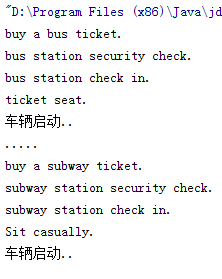
2.状态模式
程序中 经常 因状态不同,执行的不同逻辑代码 。状态模式: 就是将 这些状态 分为不同的状态对象,
且 这些状态对象 有自己的状态 行为。解耦
网上找了个例子
四种颜色
Red,
White,
Blue,
Black
有 pull和 push两种操作
Color类
public enum Color {
Red,
White,
Blue,
Black
}
操作管理类
public class Context {
private Color color;
public Context(Color color) {
this.color = color;
}
public void push(){
//red->white->blue->black
if(color==Color.Red) color=Color.White;
else if(color==Color.White) color=Color.Blue;
else if(color==Color.Blue) color=Color.Black;
}
public void pull(){
//red<-white<-blue<-black
if(color==Color.Black) color=Color.Blue;
else if(color==Color.Blue) color=Color.White;
else if(color==Color.White) color=Color.Red;
}
}
测试
public void test(){
Context context=new Context(Color.Red);
context.push();
System.out.println(context.getColor().name());
context.pull();
System.out.println(context.getColor().name());
}
结果

改用状态模式
public abstract class State {
protected abstract void push(Context2 context);
protected abstract void pull(Context2 context);
protected abstract Color getColor();
}
public class RedState extends State {
@Override
protected void push(Context2 context) {
context.setState(new WhiteState());
}
@Override
protected void pull(Context2 context) {
context.setState(new RedState());
}
@Override
protected Color getColor() {
return Color.Red;
}
}
public class WhiteState extends State {
@Override
protected void push(Context2 context) {
context.setState(new BlueState());
}
@Override
protected void pull(Context2 context) {
context.setState(new RedState());
}
@Override
protected Color getColor() {
return Color.White;
}
}
public class BlueState extends State {
@Override
protected void push(Context2 context) {
context.setState(new BlackState());
}
@Override
protected void pull(Context2 context) {
context.setState(new WhiteState());
}
@Override
protected Color getColor() {
return Color.Blue;
}
}
public class BlackState extends State {
@Override
protected void push(Context2 context) {
context.setState(new BlackState());
}
@Override
protected void pull(Context2 context) {
context.setState(new BlueState());
}
@Override
protected Color getColor() {
return Color.Black;
}
}
测试
public void test2(){
Context2 context2=new Context2(new RedState());
context2.push();
System.out.println(context2.getState().getColor());
context2.pull();
System.out.println(context2.getState().getColor());
}
运行结果

3.策略模式 strategy
strategy [ˈstratəjē]
策略模式 就是 将公共操作 ,在不同类中分别实现,也就是继承公共的接口或父类 。再用策略调用者调用自己需要的策略。
demo:
1.策略接口
public interface Strategy {
void compress();
}
2.rar压缩算法实现
public class RarStrategy implements Strategy {
@Override
public void compress() {
System.out.println("execute rar compression");
}
}
3.zip压缩算法实现
public class ZipStrategy implements Strategy {
@Override
public void compress() {
System.out.println("execute zip compression");
}
}
4.调用者类
public class Context {
private Strategy strategy;
public Context(Strategy strategy) {
this.strategy = strategy;
}
public void executeCompress(){
strategy.compress();
}
}
5.测试
public void test(){
Context context=new Context(new RarStrategy());
context.executeCompress();
context=new Context(new ZipStrategy());
context.executeCompress();
}
执行结果

4.命令模式
命令模式的目的是 将请求 封装到 类内部
命令模式可以将请求封装在一个对象中 允许你可以像管理对象一样去 管理方法 ,传递 并且在适合的机会调用它
网上找了个例子 :http://blog.csdn.net/jason0539/article/details/45110355
开关电视机的请求
现在设置 请求命令接口
public interface Command {
void execute();
}
然后 建立一个 TV对象 作为命令的接收者
public class TV {
void turnOn(){
System.out.println("The TV is turn on.");
}
void turnOff(){
System.out.println("The TV is turn off.");
}
}
开机命令
public class CommandOn implements Command {
private TV tv;
public CommandOn(TV tv) {
this.tv = tv;
}
@Override
public void execute() {
tv.turnOn();
}
}
关机命令
public class CommandOff implements Command {
private TV tv;
public CommandOff(TV tv) {
this.tv = tv;
}
@Override
public void execute() {
tv.turnOff();
}
}
控制 器 就像遥控器
public class Control {
private CommandOn commandOn;
private CommandOff commandOff;
public Control(CommandOn commandOn, CommandOff commandOff) {
this.commandOn = commandOn;
this.commandOff = commandOff;
}
public void turnOn(){
commandOn.execute();
}
public void turnOff(){
commandOff.execute();
}
}
测试
public void test() {
TV tv = new TV();
CommandOn commandOn = new CommandOn(tv);
CommandOff commandOff = new CommandOff(tv);
Control control=new Control(commandOn,commandOff);
control.turnOn();
control.turnOff();
}
执行结果

本demo将命令 开机和关机命令 封装 传递 ,并在需要的时候触发
5.解析器模式 Interpreter
扩展型设计模式
- 让开发者动态组合对象行为-->装饰器模式
- 提供一个方法 来顺序访问 集合中的元素-->迭代器模式
- 允许开发者定义新的操作 而无需改变 分层体系中的类-->访问者模式
1.装饰器模式 decorator
decorator [ˈdekəˌrātər]
经典的装饰器模式 就是java中的流处理
public void test(){
try {
FileWriter file=new FileWriter(new File("E://test//test.txt"));
BufferedWriter writer=new BufferedWriter(file);
writer.write("this is test file.");
writer.flush();
writer.close();
} catch (IOException e) {
e.printStackTrace();
}
}
这段代码中 我们从 FileWriter 组合成BufferWriter 最后输入文本;
通过构造器传入参数 ,产生了新的对象行为。
查看下 源码
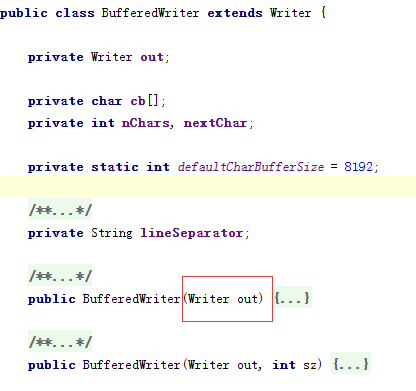
2.迭代器模式 Iterator
为顺序访问集合提供一种方式
/*
* Copyright (c) 1997, 2013, Oracle and/or its affiliates. All rights reserved.
* ORACLE PROPRIETARY/CONFIDENTIAL. Use is subject to license terms.
*
*
*/
package java.util;
import java.util.function.Consumer;
/**
* An iterator over a collection. {@code Iterator} takes the place of
* {@link Enumeration} in the Java Collections Framework. Iterators
* differ from enumerations in two ways:
*
* <ul>
* <li> Iterators allow the caller to remove elements from the
* underlying collection during the iteration with well-defined
* semantics.
* <li> Method names have been improved.
* </ul>
*
* <p>This interface is a member of the
* <a href="{@docRoot}/../technotes/guides/collections/index.html">
* Java Collections Framework</a>.
*
* @param <E> the type of elements returned by this iterator
*
* @author Josh Bloch
* @see Collection
* @see ListIterator
* @see Iterable
* @since 1.2
*/
public interface Iterator<E> {
/**
* Returns {@code true} if the iteration has more elements.
* (In other words, returns {@code true} if {@link #next} would
* return an element rather than throwing an exception.)
*
* @return {@code true} if the iteration has more elements
*/
boolean hasNext();
/**
* Returns the next element in the iteration.
*
* @return the next element in the iteration
* @throws NoSuchElementException if the iteration has no more elements
*/
E next();
/**
* Removes from the underlying collection the last element returned
* by this iterator (optional operation). This method can be called
* only once per call to {@link #next}. The behavior of an iterator
* is unspecified if the underlying collection is modified while the
* iteration is in progress in any way other than by calling this
* method.
*
* @implSpec
* The default implementation throws an instance of
* {@link UnsupportedOperationException} and performs no other action.
*
* @throws UnsupportedOperationException if the {@code remove}
* operation is not supported by this iterator
*
* @throws IllegalStateException if the {@code next} method has not
* yet been called, or the {@code remove} method has already
* been called after the last call to the {@code next}
* method
*/
default void remove() {
throw new UnsupportedOperationException("remove");
}
/**
* Performs the given action for each remaining element until all elements
* have been processed or the action throws an exception. Actions are
* performed in the order of iteration, if that order is specified.
* Exceptions thrown by the action are relayed to the caller.
*
* @implSpec
* <p>The default implementation behaves as if:
* <pre>{@code
* while (hasNext())
* action.accept(next());
* }</pre>
*
* @param action The action to be performed for each element
* @throws NullPointerException if the specified action is null
* @since 1.8
*/
default void forEachRemaining(Consumer<? super E> action) {
Objects.requireNonNull(action);
while (hasNext())
action.accept(next());
}
}
如果一个类 支持 for循环 必须实现Iterable接口 ,并提供 Iterator方法
public interface Iterable <T> {
java.util.Iterator<T> iterator();
default void forEach(java.util.function.Consumer<? super T> consumer) { /* compiled code */ }
default java.util.Spliterator<T> spliterator() { /* compiled code */ }
}
比如我们经常使用的 ArrayList
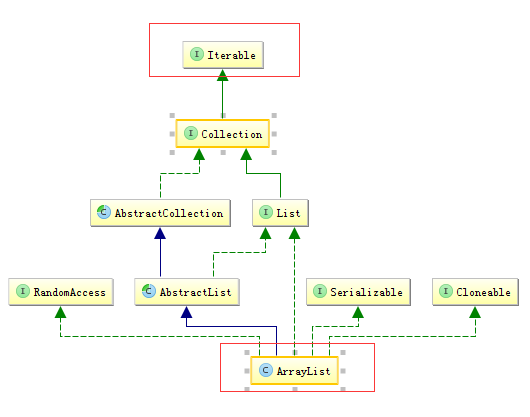
3.访问者 visitor模式
访问者模式的意图是 不改变类层次结构前提下,对该层次结构进行扩展。